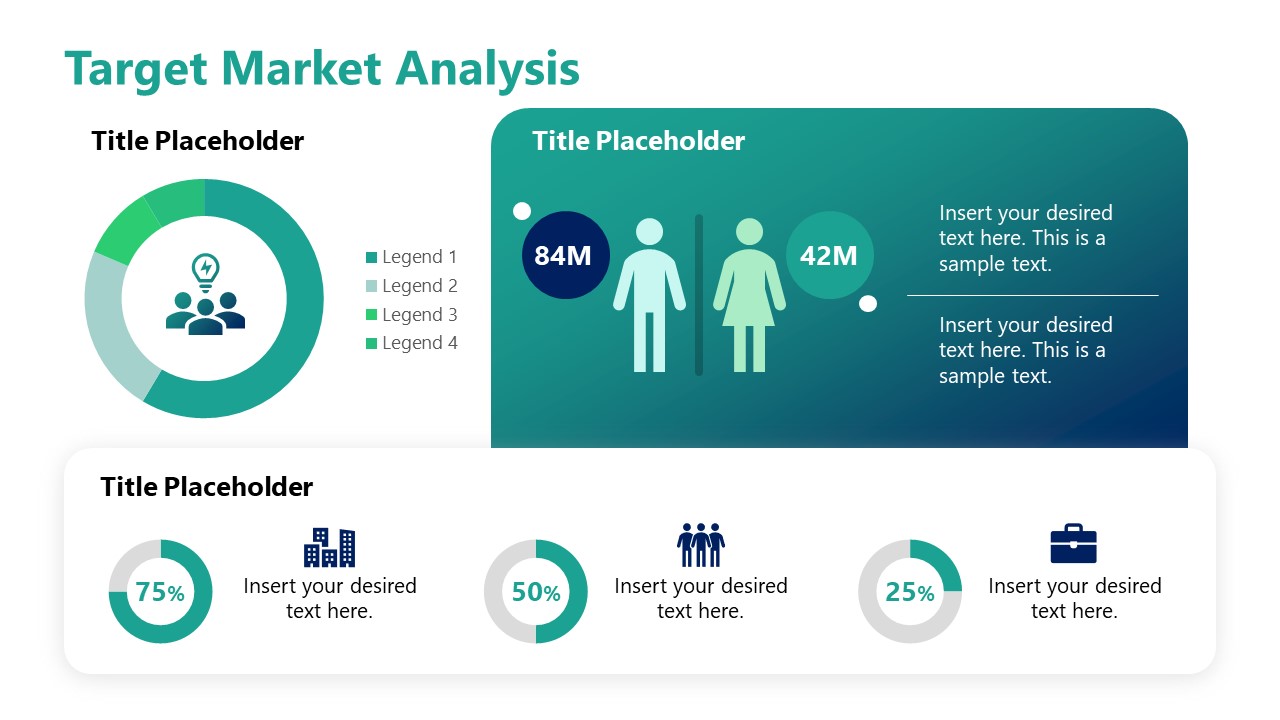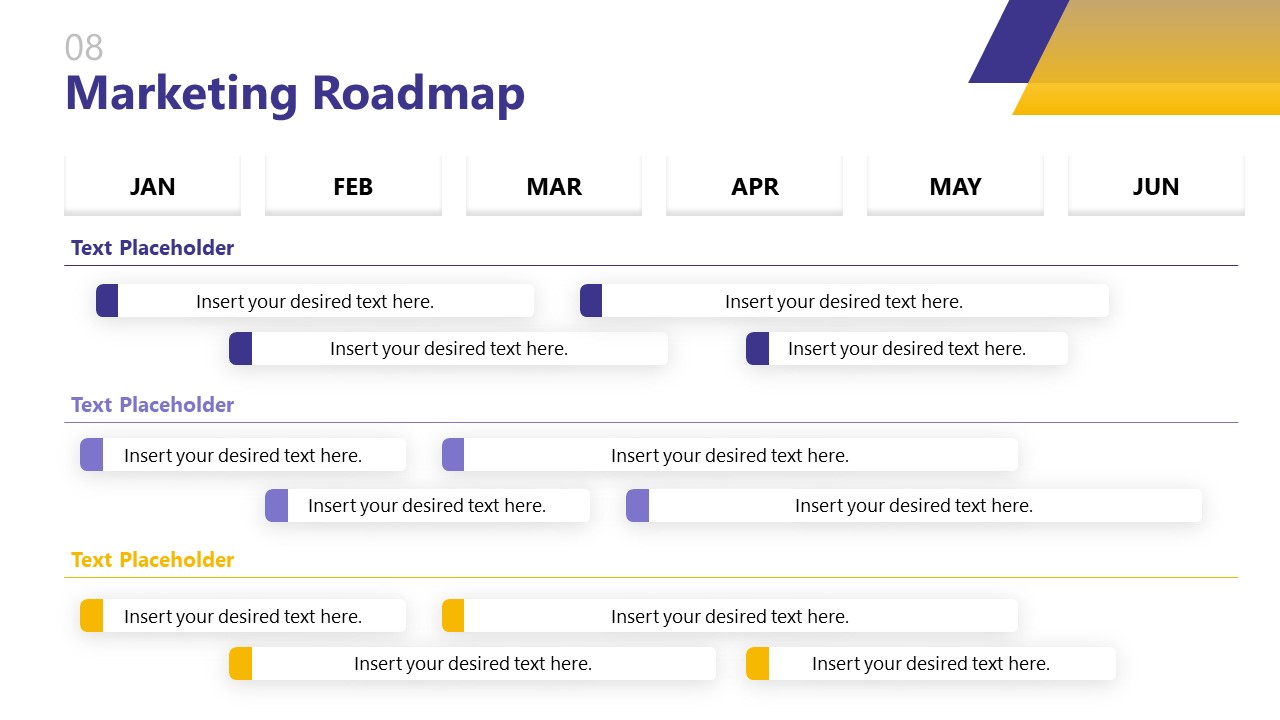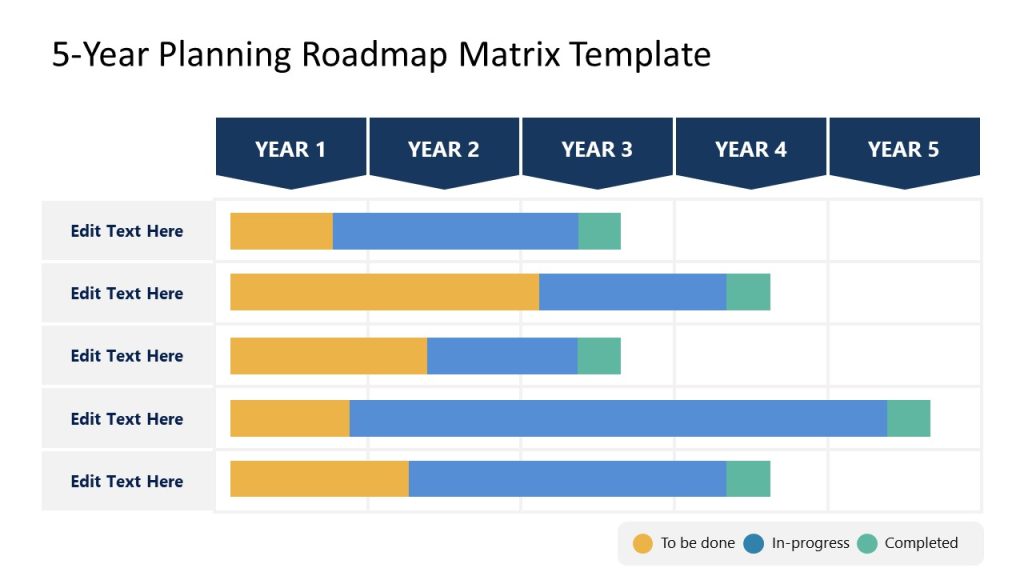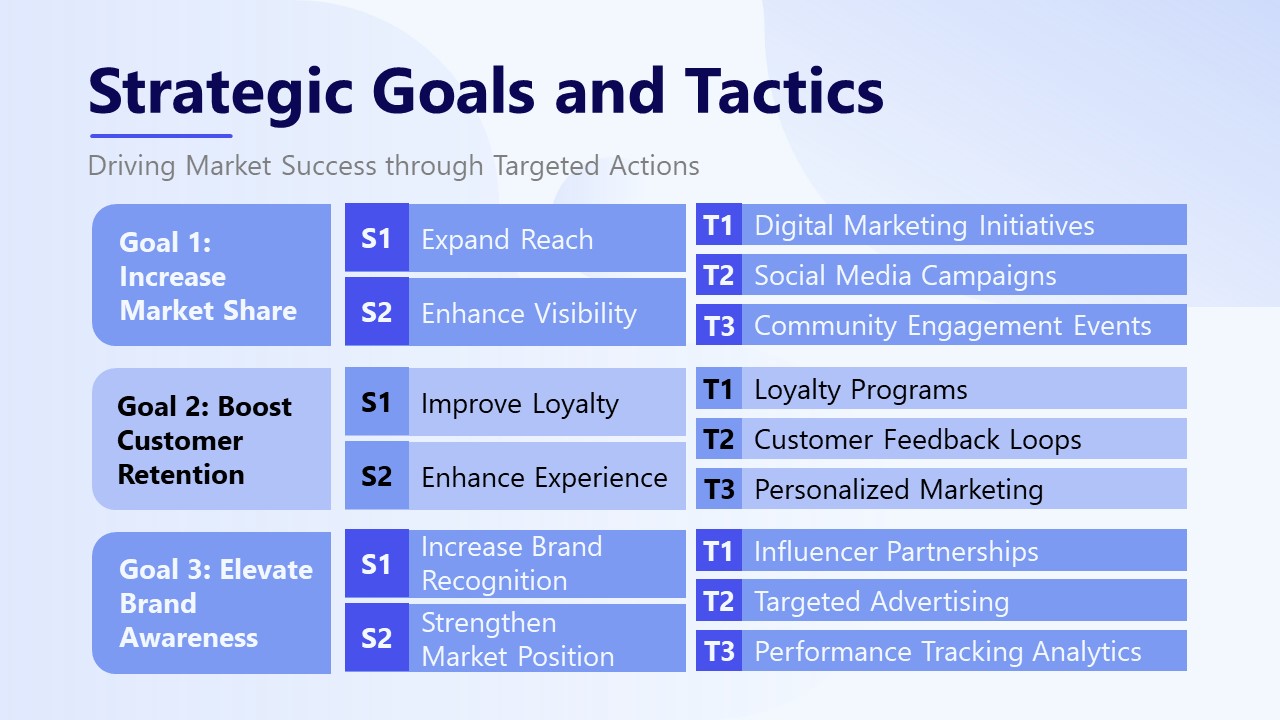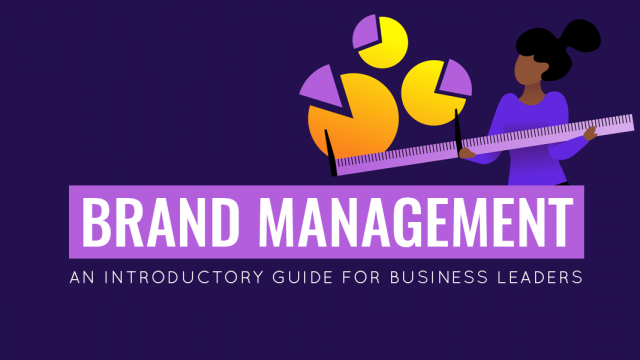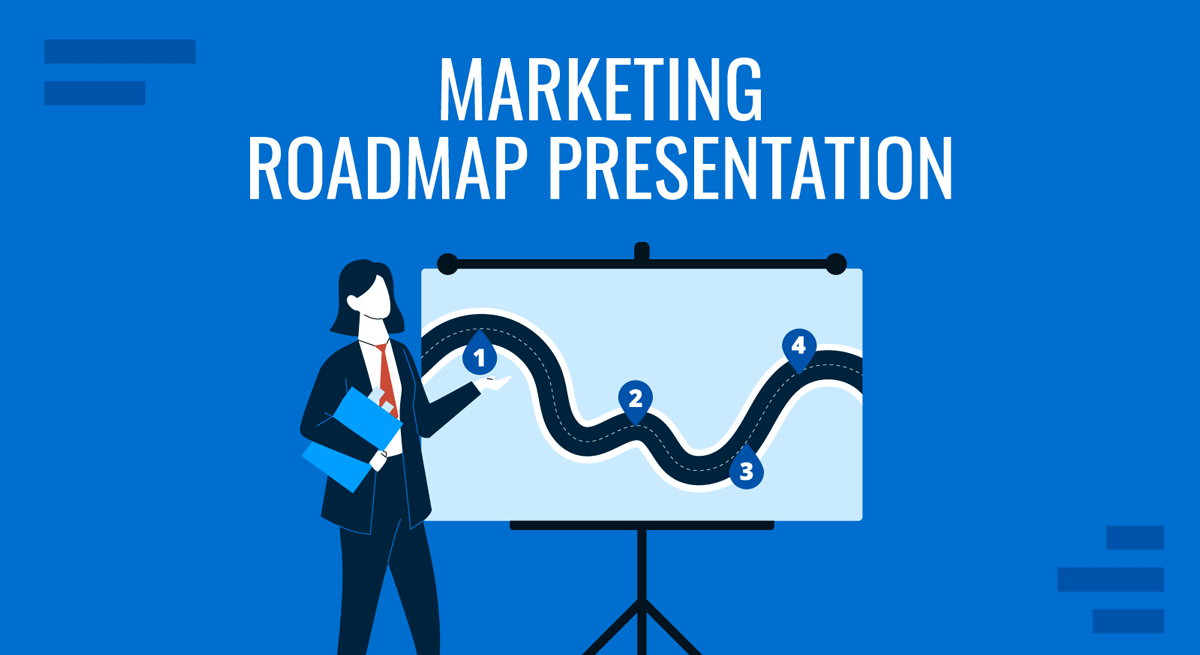
A marketing roadmap presentation is essential for teams to visualize and communicate their strategic direction over a set period. It aligns marketing initiatives with broader business goals, ensuring every effort serves a purpose within the larger organizational framework. For project managers and communication professionals, crafting a clear, high-level roadmap can improve team focus, streamline collaboration, and help stakeholders understand key milestones, resource needs, and expected outcomes. A well-prepared roadmap presentation can also highlight dependencies and critical timelines, reducing bottlenecks and helping to anticipate challenges.
This guide provides a step-by-step process for creating an effective roadmap marketing. It covers goal setting, strategy breakdown, timeline selection, and marketing roadmap template recommendations featuring SlideModel’s templates. Whether you’re planning a digital marketing campaign, a product launch, or a brand awareness initiative, this roadmap will help transform your ideas into a cohesive, actionable plan.
Table of Contents
- What is a Marketing Roadmap?
- Types of Marketing Roadmaps
- What is a Marketing Roadmap Presentation?
- Step-by-Step Guide to Creating a Marketing Roadmap Presentation
- Tips for a Successful Marketing Roadmap Presentation
- Recommended PPT Templates for Marketing Roadmap Presentations
- FAQs
- Conclusion
What is a Marketing Roadmap?
A marketing roadmap is a visual representation of marketing initiatives over a specified period. It aligns marketing activities, objectives, and timelines with the larger goals of a business or project. Unlike a detailed marketing plan, a marketing roadmap provides a high-level view that stakeholders can understand at a glance, helping teams stay focused on key priorities.
Marketing roadmaps are especially valuable for project managers and marketing professionals as they help synchronize cross-functional teams, set expectations with stakeholders, and measure progress.
Types of Marketing Roadmaps
Marketing roadmaps come in various forms, each tailored to specific objectives, strategies, and audiences. Understanding the different types helps you select the most appropriate format for your marketing goals. Here are some common types of marketing roadmaps.
Product Marketing Roadmap
A Product Marketing Roadmap (which is different from a product roadmap) promotes a specific product or product line throughout its lifecycle. This roadmap aligns marketing activities with product development stages, ensuring a cohesive approach from conception to market release. It outlines strategies for market research, product positioning, messaging, and differentiation from competitors.
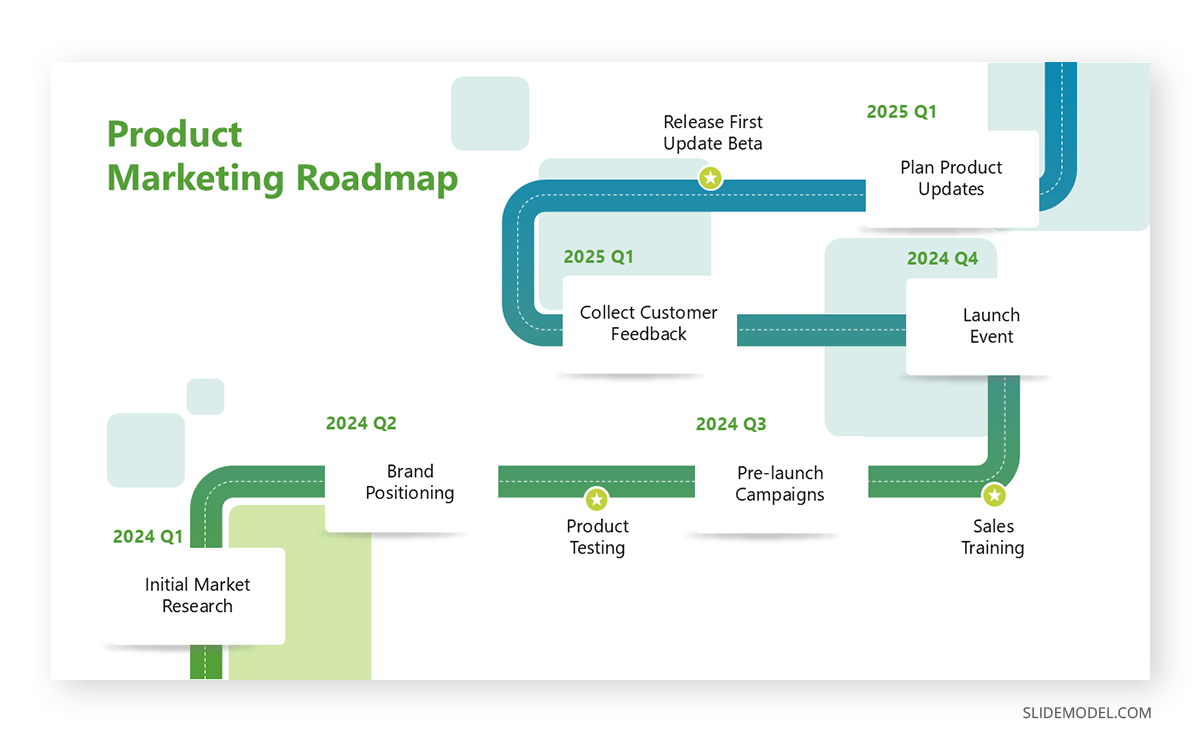
Detailing timelines for pre-launch, launch, and post-launch activities ensures that all teams—from product development to sales—are synchronized. This roadmap helps plan promotional campaigns, feature announcements, and customer feedback loops, ultimately enhancing the product’s market success. Help yourself with timeline templates to make your work easier to understand.
Digital Marketing Roadmap
The Digital Marketing Roadmap focuses on online initiatives across various digital platforms to enhance brand visibility and customer engagement. It encompasses strategies for search engine optimization (SEO), search engine marketing (SEM), content marketing, social media engagement, email marketing, and online advertising. This roadmap digital marketing maps out activities like improving website traffic, increasing online conversions, and boosting customer interaction through digital channels.
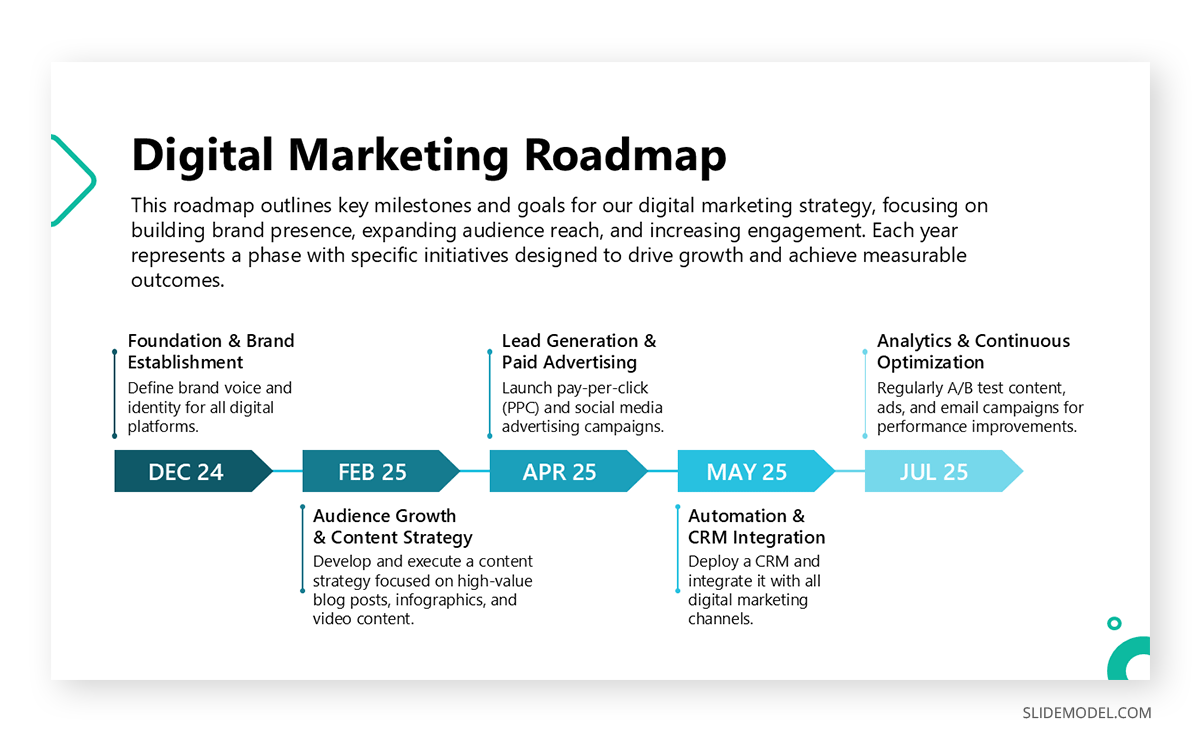
Setting clear timelines and key performance indicators for each digital strategy allows marketers to track progress, make data-driven decisions, and adjust tactics in real-time based on performance analytics.
Content Marketing Roadmap
A Content Marketing Roadmap is dedicated to planning, creating, and distributing valuable content to attract and engage a target audience. It outlines a strategic approach to developing blogs, articles, videos, webinars, podcasts, and other content types that resonate with audience needs and business objectives. This roadmap schedules content production and publication dates, identifies distribution platforms, and plans audience engagement strategies.

Providing a structured approach to content creation ensures consistent messaging and timely delivery across all channels. This builds trust and credibility with the audience, supports other marketing initiatives, and enhances customer retention through ongoing engagement.
Brand Marketing Roadmap
The Brand Marketing Roadmap is focused on building and maintaining the brand’s image, reputation, and identity in the marketplace. It involves activities that enhance brand awareness and loyalty, such as rebranding efforts, public relations campaigns, sponsorships, and community engagement initiatives. This roadmap clarifies the brand’s unique value proposition and develops consistent communication messaging guidelines. It also plans for visual identity development, including logo design, color schemes, and other visual elements contributing to brand recognition.
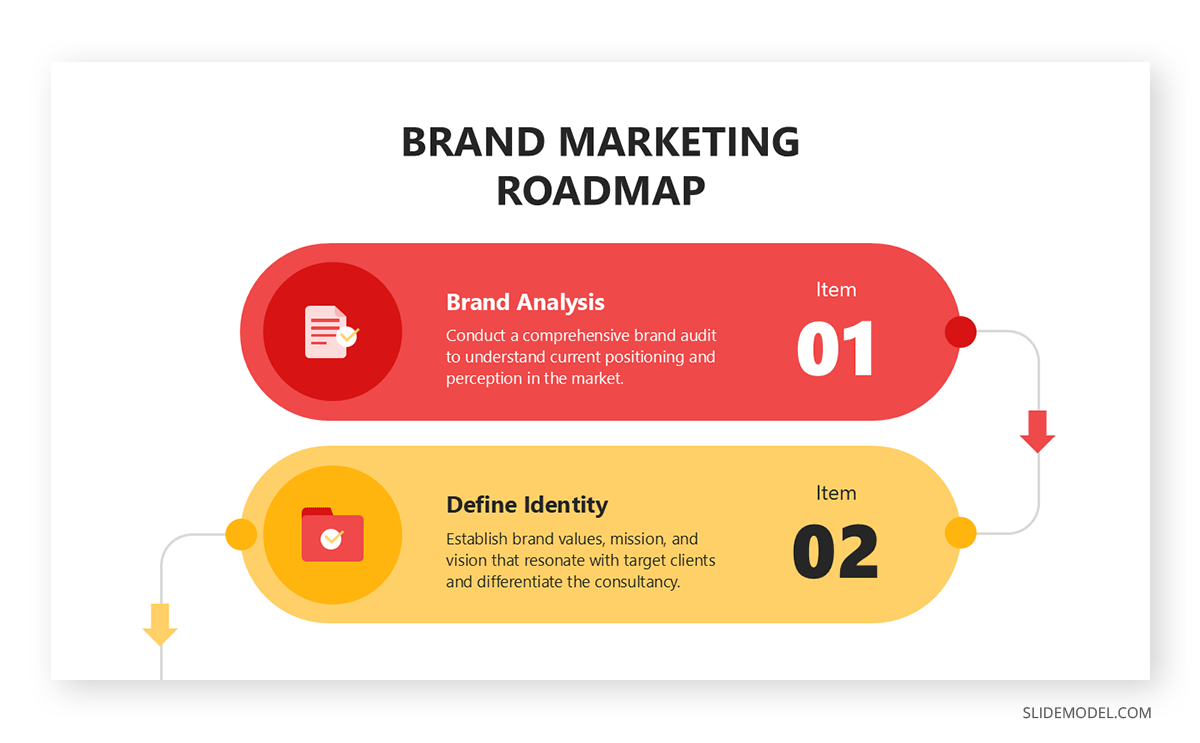
By strategically planning these efforts, the roadmap ensures consistency across all marketing channels, strengthens brand loyalty and enhances perceived value and trust among consumers.
Strategic Marketing Roadmap
A Strategic Marketing Roadmap provides a high-level plan that aligns marketing objectives with the company’s long-term business goals. It covers broad initiatives such as entering new markets, targeting new customer segments, or launching comprehensive marketing campaigns that span multiple channels and tactics. The marketing strategy roadmap outlines market expansion plans, customer acquisition and retention strategies, potential partnerships and alliances, innovation initiatives, and resource allocation for sustained marketing efforts.
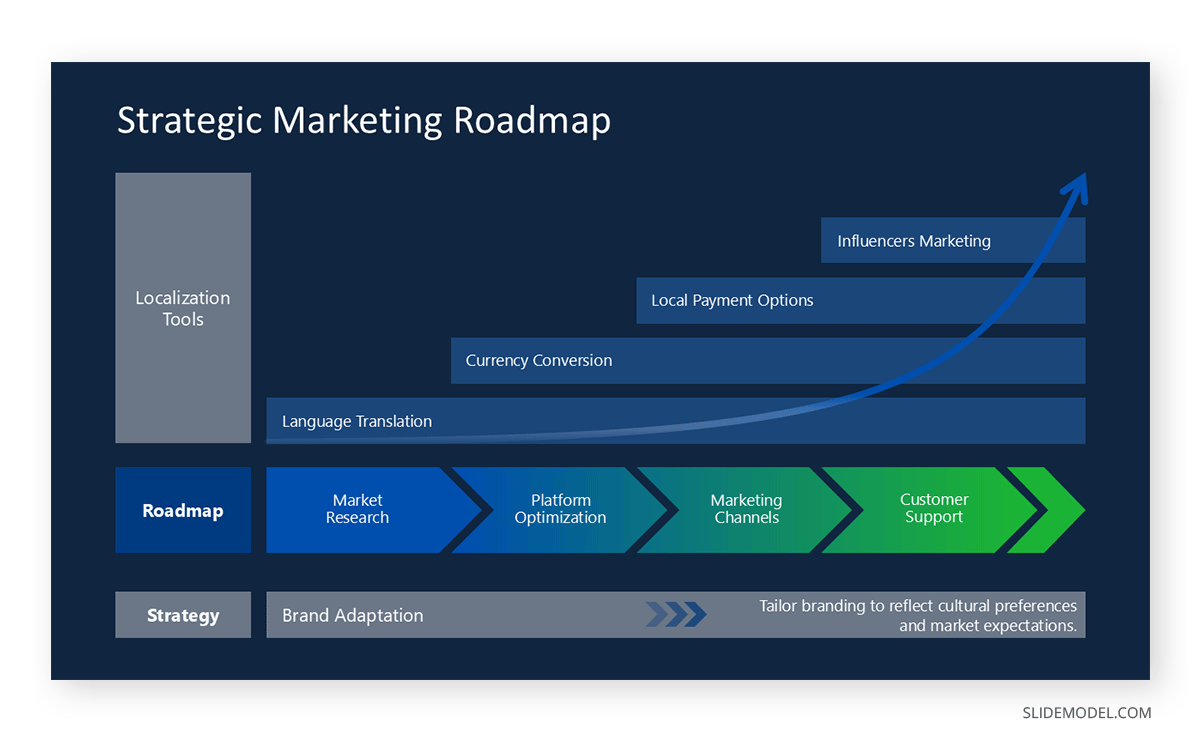
Offering a clear vision for marketing’s role in company growth helps secure executive buy-in, facilitates cross-departmental alignment, and guides overall marketing direction over multiple years.
Campaign Marketing Roadmap
The Campaign Marketing Roadmap is tailored for specific marketing campaigns, detailing the tactics and timelines required to achieve campaign objectives. It includes specific goals such as increasing sales by a certain percentage or boosting event attendance. This roadmap outlines the marketing mix to be used—such as advertising, promotions, digital marketing, and other tactics—and specifies target audiences, messaging strategies, media channels, and performance metrics for the campaign duration.
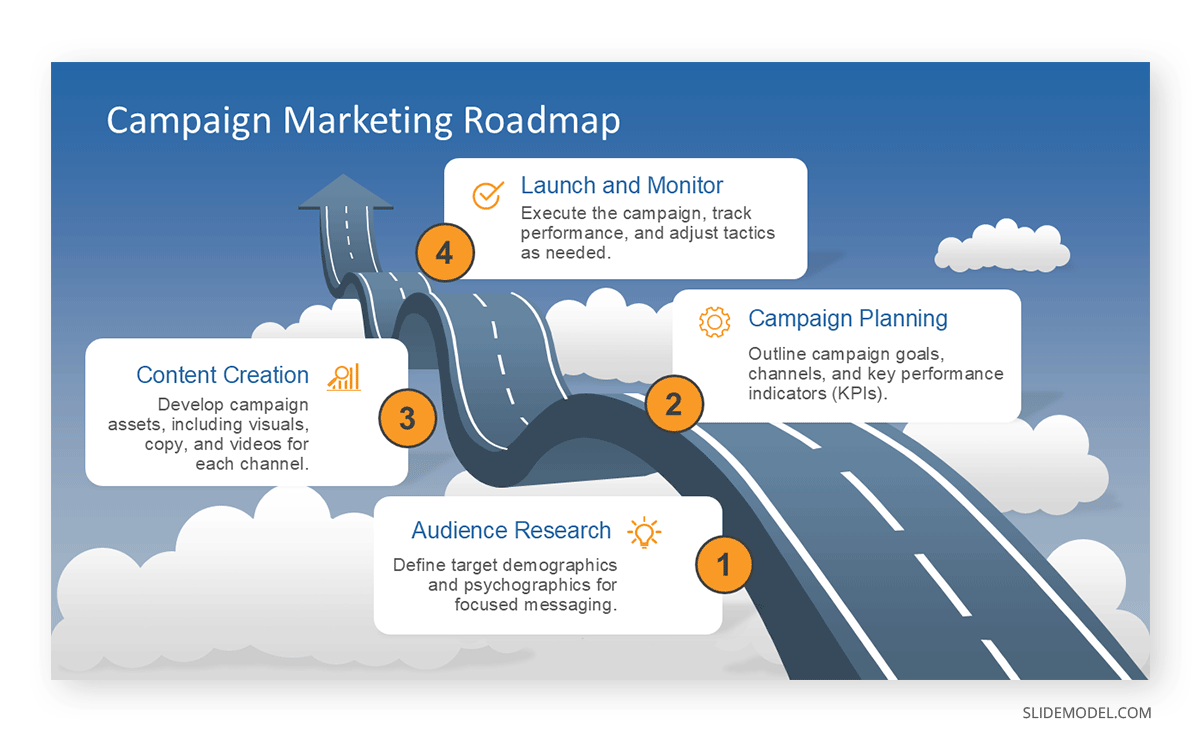
Providing clarity and focus for all team members facilitates tight coordination, ensures timely execution, and allows for precise measurement of campaign effectiveness.
Channel-Specific Marketing Roadmap
A Channel-Specific Roadmap concentrates on strategies within a single marketing channel to maximize effectiveness. Whether focusing on social media, email marketing, search engine marketing, or another specific channel, this roadmap delves deep into strategies and tactics tailored to that channel. It outlines content calendars, engagement plans, growth strategies, and metrics to monitor performance.
Enabling deep specialization and optimization helps identify and capitalize on channel-specific opportunities, allowing for quick iteration and improvement based on feedback. This focused approach is handy when a specific channel is crucial for reaching the target audience or experimenting with new platforms.
Integrated Marketing Roadmap
An Integrated Marketing Roadmap combines multiple channels and tactics to deliver a unified message across all touchpoints. It ensures consistency in brand voice and messaging, coordinating efforts across channels to reinforce messaging and increase impact. This roadmap maps marketing activities to stages in the customer lifecycle, providing a seamless experience from initial awareness to post-purchase engagement.
Aggregating data from all channels offers a comprehensive view of performance, maximizing the reach and effectiveness of marketing efforts. This holistic approach enhances customer engagement and improves efficiency by reducing duplicated efforts and ensuring that all marketing activities are aligned.
How to Choose a Marketing Roadmap Type
Selecting the appropriate marketing roadmap is crucial for aligning your marketing deck with your specific objectives. Each type of roadmap serves a distinct purpose, so understanding which one fits your needs will enhance the effectiveness of your marketing efforts.
- Product Marketing Roadmap: If you’re launching a new product or updating an existing one, this roadmap is ideal. It focuses on marketing activities aligned with product development stages, helping you plan promotional campaigns, feature announcements, and market positioning tied to product milestones.
- Digital Marketing Roadmap: Choose this when aiming to enhance your online presence and customer engagement. It outlines strategies for SEO, content marketing, social media, email campaigns, and online advertising, allowing you to map out activities that improve website traffic and boost digital interactions.
- Content Marketing Roadmap: Opt for this when your goal is to attract and engage your audience through valuable content. It schedules the creation and distribution of blogs, videos, webinars, and other content types, ensuring consistent messaging and timely delivery across all channels.
- Brand Marketing Roadmap: This is suitable if you’re focused on building or maintaining your brand’s image and reputation. It involves activities like rebranding efforts, public relations campaigns, and community engagement initiatives to strengthen brand awareness and loyalty.
- Strategic Marketing Roadmap: Use this to align marketing objectives with long-term business goals. It covers broad initiatives such as entering new markets or targeting new customer segments, providing a high-level plan that guides overall marketing direction over multiple years.
- Campaign Marketing Roadmap: Ideal for specific, time-bound campaigns with clear objectives. It details tactics, timelines, target audiences, and performance metrics for initiatives like product launches or promotional events, ensuring tight coordination and precise measurement of effectiveness.
- Channel-Specific Roadmap: Select this when you need to maximize the effectiveness of a single marketing channel, such as social media or email marketing. It allows for deep specialization and optimization within that channel, helping you capitalize on specific opportunities.
- Integrated Marketing Roadmap: Choose this when delivering a unified message across all touchpoints is essential. It combines multiple channels and tactics to ensure consistency in brand voice and messaging, enhancing customer engagement and maximizing the reach of your marketing efforts.
What is a Marketing Roadmap Presentation?
Now that we’ve defined what a marketing roadmap is and its different styles, it’s time to put into words what we mean by a marketing roadmap presentation.
A Marketing Roadmap Presentation is a strategic tool visually outlining an organization’s marketing initiatives, goals, and timelines over a specific period. It serves as a high-level plan that communicates the direction of marketing efforts to stakeholders such as team members, executives, and partners. The presentation details key marketing activities, campaigns, product launches, and promotional events, aligning them with the company’s overall business objectives.
This roadmap helps coordinate cross-functional teams by clarifying priorities, resource allocation, and expected outcomes. It often includes elements like timelines, milestones, target audiences, channels, and key performance indicators (KPIs). By presenting this information cohesively, a marketing roadmap ensures that everyone involved understands the strategic plan, facilitating better collaboration and more effective execution of marketing strategies.
Step-by-Step Guide to Creating a Marketing Roadmap Presentation
Step 1: Define Marketing Goals and Objectives
Before building the roadmap, define the primary objectives you aim to achieve. For instance, goals may include increasing brand awareness, driving leads, or launching a product. Defining objectives helps shape the roadmap’s structure and content and ensures all initiatives align with overarching business goals.
Step 2: Understand the Audience and Stakeholders
A marketing roadmap presentation often involves communicating with multiple stakeholders, including executives, product managers, and sales teams. Knowing the expectations of each audience type will help shape the messaging of your roadmap presentation and determine the level of detail to include.
Step 3: Break Down Marketing Strategy into Key Initiatives
With your goals defined, outline the main initiatives that will drive progress toward each goal. For example:
- Content Marketing – Include campaigns for blog posts, whitepapers, and case studies.
- Digital Advertising – Plan for PPC campaigns, social media ads, and other paid media strategies.
- SEO and Web Optimization – List initiatives to improve organic search visibility.
- Each initiative should have a timeline, resource allocation, and key metrics for tracking.
Step 4: Choose the Right Time Frame
Determine whether the roadmap will be quarterly, bi-annual, or annual. Quarterly roadmaps are ideal for fast-paced industries where strategies change frequently. An annual roadmap is useful for campaigns with longer timelines and a focus on gradual growth.
Step 5: Select a Format for Your Marketing Roadmap
Marketing roadmaps can take various formats, each with its advantages:
- Timeline-Based – Ideal for sequential tasks with specific start and end dates.
- Kanban-Style – Useful for agile teams, with tasks organized in stages. Check our guide on Kanban Boards to learn more about this.
- Gantt Chart – Perfect for detailed project tracking, showing dependencies between tasks. Our article on Gantt Charts can help you create your marketing roadmap.
The chosen format should help stakeholders understand the timeline, dependencies, and priorities.
Step 6: Create the Marketing Roadmap Presentation
Use PowerPoint or Google Slides to organize your roadmap visually. Here’s how to structure your presentation effectively:
- Cover Slide – Include the title, date, and purpose of the presentation.
- Objectives Slide – Highlight the marketing goals and objectives.
- Roadmap Overview Slide – Present a high-level view of the entire roadmap.
- Detailed Slides by Initiative – Break down each initiative with timelines, KPIs, and key milestones.
- Resource and Budget Allocation – Showcase the resources, personnel, and budget associated with each initiative.
- Metrics and Success Measurement – Identify how progress will be tracked.
Tips for a Successful Marketing Roadmap Presentation
Use Visual Aids Effectively
Incorporate charts, graphs, and visuals to simplify complex information. A well-designed visual can convey timelines, milestones, and relationships between initiatives more effectively than text-heavy slides, enhancing comprehension and retention.
Highlight Key Milestones
Emphasize the critical points in your roadmap that signify progress, such as product launches or campaign kick-offs. Highlighting these milestones keeps the audience aware of significant events and fosters a sense of anticipation and momentum.
Align with Business Goals
Demonstrate how the marketing roadmap supports the organization’s broader objectives. Connecting your initiatives to business goals shows strategic alignment and justifies the resources allocated to your marketing efforts.
Address Potential Risks and Challenges
Acknowledge any obstacles that might impact your marketing initiatives, such as market trends or resource constraints. Discussing potential challenges demonstrates foresight and prepares stakeholders for possible adjustments.
Incorporate Measurable Metrics
Include key performance indicators (KPIs) that will be used to measure success. Defining metrics provides clarity on expectations and enables tracking progress over time, which is crucial for accountability and ongoing optimization.
Tell a Compelling Story
Structure your presentation as a narrative to engage your audience emotionally. Begin with your organization’s challenges or opportunities, and then show how the marketing roadmap addresses them. A storytelling presentation approach makes the information more relatable and memorable.
Show Resource Allocation
Detail how resources like budget, personnel, and tools will be allocated for each initiative. Transparent resource planning helps stakeholders see the feasibility of your roadmap and prepares them for any required investments.
Incorporate Competitive Analysis
Include insights into how your marketing strategies position the organization against competitors. Demonstrating awareness of the competitive landscape adds depth to your roadmap and justifies your strategic choices.
Recommended PPT Templates for Marketing Roadmap Presentations
In this section, we will list our selection of best roadmap templates for creating your marketing roadmaps with ease. Remember, these PowerPoint templates also work as Google Slides templates, and are entirely editable to match your organization’s brand identity and requirements.
FAQs
What should be included in a marketing roadmap presentation?
Key components include goals, target audience, initiatives, timelines, milestones, channels, metrics, and resource allocation. Visual elements like timelines and milestones help enhance clarity.
How does a marketing roadmap differ from a marketing plan?
A roadmap provides a high-level timeline and sequence of activities, focusing on “what” and “when.” A marketing plan is more detailed, covering the “how,” including tactics, budgets, and individual campaign details.
How far ahead should a marketing roadmap cover?
It depends on the business’s pace and goals; typically, roadmaps cover quarterly, bi-annual, or annual periods, but some strategic plans may extend up to 3-5 years.
What are common formats for a marketing roadmap presentation?
Common formats include Gantt charts, timeline-based slides, Kanban-style boards, and matrix layouts. The format chosen should support a clear view of priorities and timelines.
What’s the best way to visualize timelines in a marketing roadmap?
Gantt charts, timeline slides, and sequential roadmaps work well to visualize timelines, as they show each initiative’s start and end dates, dependencies, and progress.
How often should a marketing roadmap be updated?
It should be reviewed and updated regularly—typically quarterly or bi-annually—to adapt to market changes, adjust goals, and reflect completed or postponed initiatives.
How do you measure success in a marketing roadmap?
Success is measured by tracking metrics tied to specific goals, such as lead generation, brand awareness, engagement rates, and conversion metrics for each initiative.
What are some common challenges in creating a marketing roadmap presentation?
Challenges include setting realistic timelines, aligning cross-functional teams, balancing long-term goals with short-term needs, and adapting to market changes.
Can a marketing roadmap include both online and offline activities?
Yes, a comprehensive marketing roadmap often includes both digital and traditional channels, such as social media, events, email campaigns, and direct mail, for a fully integrated approach.
Conclusion
Building a marketing roadmap presentation requires careful planning, alignment with business goals, and an effective communication strategy for stakeholder buy-in. For project managers and communication professionals, using a well-organized template from platforms like SlideModel can save time and improve the clarity of the roadmap.
With this guide, you can approach roadmap creation systematically, ensuring your presentation effectively communicates your marketing strategy. A well-crafted marketing roadmap aligns your team’s efforts with organizational goals and helps everyone stay on track toward achieving shared objectives.
